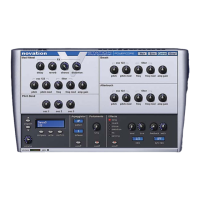Using the V-Station
Using the V-Station
If you are already familiar with analogue synthesizers and VSTi / Audio Unit plug-ins, you can
probably get started immediately. The most important parameters are on the MAIN panel but
other, lesser used functions can be found on sub-pages EXTRA, CONTROLS and GLOBAL.
These are accessed by clicking on the buttons at the top right of the window and should be
fairly self-explanatory. Further details regarding operation of these panels are included later in
this operator’s manual.
Selecting programs
Probably the best way to get a feel for the V-Station is to play the factory presets that are
supplied.
The V-Station comes supplied with 400 program memory locations of which the first 200 are
occupied with factory presets. These presets can be selected and auditioned simply by
clicking on the PROGRAM up/down buttons to the left of the LCD in the bottom left of the
window. It is worthwhile going through these to get a feel for the sounds the V-Station is
capable of. Amongst them you will find a wide range of synth basses, pads, arpeggiators and
other dramatic sounds to get you started.
It is also possible to select sounds using your computer’s numeric keypad - simply type in a
three digit number (100-400) to select a specific program number.
To select sounds using your computer keyboard’s numeric keypad, the NUMPAD PROGRAM
SELECT preference must be enabled in the GLOBAL page.
Note : Some sequencers use the numeric keypad for play, stop, locating and other functions.
Some sequencers allow you to re-assign these so that you can use the keypad for other
purposes. Others, however, do not. If your sequencer doesn’t allow you to re-assign the
numeric keypad, you won’t be able to select programs numerically. You should switch
NUMPAD PROGRAM SELECT off.
Editing sounds
The V-Station’s panel(s) can be edited much like the K-Station’s real panel - not quite as direct
perhaps as reaching out and tweaking a knob but....
Simply move your mouse over the control you want to change. On the Mac, the cursor will
change to a ‘hand’ and on a PC, the cursor will change to a ‘cross-hair’ symbol. The selected
parameter and its value will be shown on the LCD:
Click on the control and move the mouse up or down. As the control is moved, the value
changes in the display. You will also note that ‘LEDs’ around the control will illuminate to give
you visual feedback of the control’s setting as it is adjusted.
Switches can be enabled / disabled simply by clicking on them. Also, some selections such as
oscillator and LFO waveforms, oscillator octave, filter slope, effects selection, etc., are selected
by clicking on their LEDs directly:
5 Getting Started

